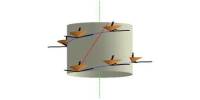The emission of light from collapsing bubbles in a liquid when stimulated by sound is known as sonoluminescence. When little gas bubbles in a liquid are exposed to powerful acoustic vibrations, they create flashes of light. The term “sonoluminescence” comes from three Latin words: “sono” (sound), “lumen” (light), and “escence” (a suffix denoting a process or state). This phenomenon has been investigated since the early twentieth century, but it received more attention in the late twentieth century as experimental techniques advanced.
Sonoluminescence was discovered at the University of Cologne in 1934. It happens when a strong enough sound wave causes a gaseous chamber within a liquid to collapse quickly, releasing a flare of light. The phenomenon can be observed in stable single-bubble sonoluminescence (SBSL) and multi-bubble sonoluminescence (MBSL).
Peter Jarman postulated in 1960 that sonoluminescence is thermal in nature and may result from microshocks within collapsing cavities. Later investigations demonstrated that the temperature inside the bubble might reach 12,000 kelvins during SBSL. The precise process of sonoluminescence is uncertain, however many possibilities include hotspot, bremsstrahlung, and collision-induced radiation.
The process typically involves the following steps:
- Bubble Formation: A small gas bubble is introduced into a liquid, often by injecting a noble gas such as helium or xenon.
- Acoustic Wave Application: The liquid is subjected to intense acoustic waves, usually generated by high-frequency sound waves. This causes the bubble to undergo rapid, periodic compression and expansion.
- Bubble Collapse: As the acoustic pressure increases during compression, the bubble collapses violently during the rarefaction phase. This collapse can generate extremely high temperatures and pressures within the bubble.
- Light Emission: During the collapse phase, the high temperatures and pressures can lead to conditions resembling those inside a star, causing the emission of a flash of light known as sonoluminescence. The emitted light is typically very short-lived, on the order of picoseconds.
The precise process underlying sonoluminescence is still being researched and debated. Some hypotheses propose that the extreme temperatures and pressures generated during bubble collapse are responsible for triggering a small fusion event, similar to what occurs in stars. The severe conditions required for continuous fusion, on the other hand, are difficult to achieve in these laboratory studies.
Temperatures in sonoluminescent systems have been speculated to reach millions of kelvins, perhaps generating thermonuclear fusion; however, this concept has been received with skepticism by other experts. The phenomenon has been observed in nature as well, with the pistol shrimp being the first known example of an animal emitting light via sonoluminescence.
Applications
Sonoluminescence has prospective applications in sectors like as medical imaging and cavitation research, but its practical application is still being researched. The phenomenon is also remarkable from the standpoint of fundamental physics, as it includes the interaction of acoustics, fluid dynamics, and thermodynamics on very small sizes.
















